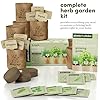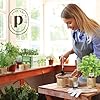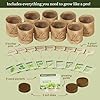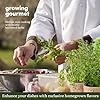Land Guard 8×4×2 ft Galvanized Raised Garden Bed Kit, Galvanized Planter Raised Garden Boxes Outdoor, Large Metal Raised Garden Beds for Vegetables.
23% OffCOATTOA Raised Garden Bed, Outdoor Galvanized Planter Boxes, Galvanized Garden Beds Outdoor with Metal Plant Stakes, Large Raised Garden Stock Tank, Garden Beds for Vegetables Planter 4×2×1ft
15% OffAre you tired of throwing away food waste and watching it end up in landfills? Do you want to reduce your carbon footprint and create a more sustainable lifestyle? If so, composting may be the answer for you. Composting is an easy way to recycle organic matter into nutrient-rich soil that can benefit both your garden and the environment. In this article, we’ll cover everything you need to know about getting started with composting at home.
What Is Composting?
Composting is the process of breaking down organic material such as food scraps, yard waste, and animal manure into a rich, fertile soil amendment called compost. This natural decomposition process is facilitated by microorganisms including bacteria, fungi, and insects. By providing these microbes with the right conditions, you can speed up the composting process and create high-quality compost in just a few months.
Why Should You Compost?
There are many reasons why you should consider composting at home. Here are some of the top benefits:
Reduce Waste: Composting allows you to divert food waste and other organic materials from the landfill, reducing greenhouse gas emissions and preserving valuable space in our overburdened waste disposal systems.
Create Nutrient-Rich Soil: Compost is packed full of essential nutrients that plants need to grow healthy and strong. Using homemade compost in your garden can help improve soil structure, increase plant vigor, and reduce the need for chemical fertilizers.
Save Money: Composting can save you money on fertilizer costs and reduce your overall environmental impact. Instead of sending your food waste to the landfill, you can turn it into a valuable resource that can benefit your garden and the planet.
How To Start Composting At Home
Getting started with composting is easier than you might think. Here are the basic steps you need to follow:
Step 1: Choose A Compost Bin
There are many different types of compost bins available, ranging from simple piles to rotating barrels. The key is to choose a bin that suits your needs and fits comfortably in your outdoor space. Some popular options include tumbling composters, static composters, and worm bins.

Step 2: Collect Your Materials
To start composting, you will need three main ingredients: browns (dry materials like leaves or shredded paper), greens (wet materials like food scraps or grass clippings), and water. You will also need air and heat to encourage the growth of beneficial microorganisms.
Step 3: Build Your Pile
Once you have collected your materials, it’s time to build your compost pile. Begin by adding a layer of browns followed by a layer of greens. Alternate between layers until you reach the desired height of your pile. Be sure to moisten each layer thoroughly and mix in any additional materials like kitchen waste or soil amendments.
Common Mistakes To Avoid When Composting
While composting is generally a straightforward process, there are several common mistakes that can slow down or even halt the decomposition process. Here are a few things to avoid when starting your compost pile:
Not mixing Browns and Greens properly
Overwatering or Under-Watering your pile
Adding meat or dairy products which attract unwanted pests
Turning your pile too frequently or not enough
Tips For Successful Composting
Here are some tips to ensure successful composting:
Keep your pile moist but not soggy
Add fresh materials regularly
Mix in carbon-rich materials like dried leaves or shredded paper
Use a balanced mixture of browns and greens
Turn your pile every two weeks to aerate the materials
Using Your Homemade Compost In The Garden
Once your compost has fully decomposed and reached maturity, you can use it in your garden to enhance soil health and promote plant growth. Here are some ways to incorporate your homemade compost into your garden:
Mix it into the soil before planting
Apply a thin layer around established plants
Make tea by steeping compost in water and using it as a foliar feed
Troubleshooting Problems With Your Compost Pile
If you encounter problems with your compost pile, here are some potential solutions:
If your pile is too wet, add dry brown materials like leaves or newspaper
If your pile is too dry, add green materials like food scraps or grass clippings
If your pile smells bad, turn it more frequently or add activated charcoal
In conclusion, composting is a great way to reduce waste, create nutrient-rich soil, and live a more sustainable life. Whether you’re new to composting or looking to improve your existing practice, following these guidelines can help you get started and achieve success.















































